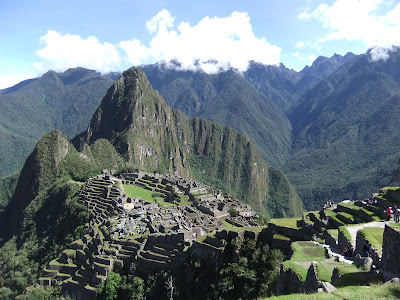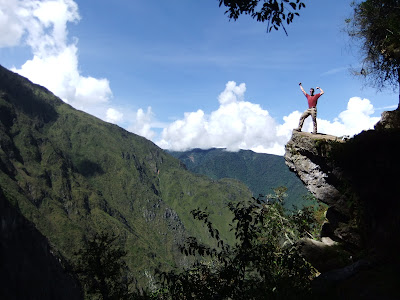Generally when I sit down to write a blog entry I’m usually somewhere between my second or third cup of coffee before anything worth writing emerges from the twisted and cryptic jungle of my mind. This entry, however, came a bit easier. The sheer volume of events in the past few days made choosing enough for this post a breeze.
I have arrived in Urubamba! I made my rendezvous with Aisha (the volunteer coordinator) only a mere 54 hours ago, but the happenings of the past few days could easily make you think otherwise. Even the most mundane of events can appear quite extraordinary when you’re adjusting to a new home. What does that make normally extraordinary events?
The small city of Urubamba takes its name from the river valley it is set in. It is large enough to keep you entertained, but small enough that everyone is still in everyone’s business: the trademark of any truly small town. I have been told that dancing is an integral part of the social contract and that if you miss an evening out on the town then you better have a good alibi: expect many questions about your whereabouts the following day.
 |
| I didn't even bother to mention the mountains surrounding the city. |
The staff-house that I am staying in is far from luxurious, but it is home. It does contain what I am beginning to call my “Holy Trinity”: hot water, a sharp knife, and a clean bed. The vast majority of places I have stayed during my travels the past month have been missing at least one of the three. The volunteers and staff members that I have met so far have all been exceptionally amiable persons. Considering that nearly all of them have been female they may just be pleased to have such a stunningly gorgeous man, such as myself, around.
You never know.
Speaking of lucky people, I was fortunate enough to time my arrival here in Urubamba with the annual event of “Carnaval”. For those of you that were unaware, as I was a short few days ago, Carnaval is something of a big deal for this small town. In what amounts to nothing less than a full day fiesta the entirety of the population of Urubamba and the surrounding cities descend from the mountains for a full day of music, dancing, drinking, and water-fights. Dressed in their finest traditional Peruvian clothing the sea of colorfully adorned crowd includes persons of all social rank from simple peasants all the way up to mayors and governors. And everyone was ready to have a good time.
 |
| A colorful sea of ponchos, chullos, and... plants. |
 |
| I begrudgingly did my best to fit in. |
The festivities start early in the morning and with the assistance of many beers the event culminates with the mid-afternoon event of “The Axing of the Trees”. Several trees "volunteered" in advance for this great honor and were dressed appropriately for the event. Ornamented with sacrificial robes of ribbons and “gifts” ranging from laundry baskets to colanders the trees patiently awaited their fate.
 |
| So brave. How kind of the tree to offer itself up in sacrifice. |
Inside the large circle of onlookers an inner ring of dancers held hands and began to dance around the chosen tree in time with the local brass band. Included in this inter-circle of dancers were all the who’s who of the region: the mayors of Urubamba, Chinchero, and Ollantaytambo. The mayors and other important persons would then take turns stepping into the circle of dancers. They would be presented with an axe and once they had taken several swings at the ceremonial tree they would pass the axe on to the next dignitary.
 |
| Don't mess with the major of Chinchero. |
As soon as the tree hit the ground the enthusiastic crowd of on-lookers, suddenly possessed by an acute case of animality, burst forward as if water from a broken dam and stripped the tree of its loot. The ensuing chaos as persons in the crowd joyfully jumped over one another in a mad attempt to claim their share of the prize was shocking, but it passed within seconds as everyone either skipped away carrying their war trophies or nonchalantly walked away empty-handed. It was all in good fun.
This was repeated three times with equal vigor.
After the “Axing of the Trees” the festival turned into an outdoor concert which continued well into the night. If you want to see the true importance of dancing in Peruvian culture just watch a crowd of drunken concert goers. With each subsequent hour the crowd appears to dissolve into one large pool of wobbly-legged dancers all doing their own form of drunken tango or folk dancing. The Peruvians don’t become “falling down drunk” they become “dancing down drunk”. The more they drink the more they do this special jig where it appears their legs are shrinking and they resolutely fight to keep standing.
I am taking pleasure from diving headfirst into the culture of my new home in Urubamba and I have no worries about myself enjoying the next month here.
¡Hasta Pronto!
P.S. This was meant to be posted several days ago, but the internet here in Urubamba is patchy at the best of times.
P.P.S. I am disappointed by the lack of challengers to my three-month-beard-off. I have no choice to to crown myself "Champion Short-Term Beard Grower". Hurrah!



















